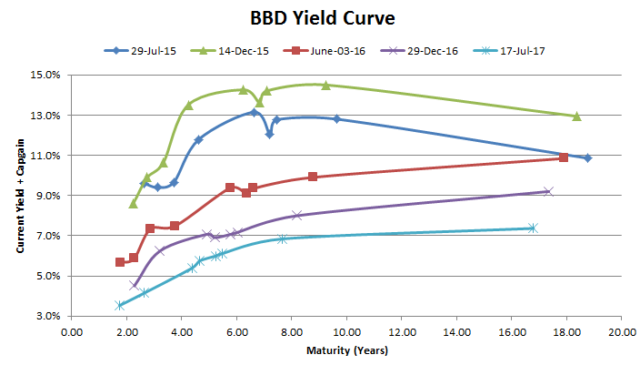Take a look at the current snapshot of short-term interest rate futures (for those that do not know how they trade, ZQ is the 30-day Fed Funds rate futures and BAX are the Canadian 3-month banker acceptance rate futures, our closest proxy – the price is 100 minus the implied rate in percentage, so a price of 97.6 would equate to a 2.4% rate):
This creates some interesting financial bets, such as:
1. Do you believe the Fed will continue raising rates?
2. Do you believe the Bank of Canada will raise rates? If so, you can easily bet on this outcome. The next two policy announcements are on January 9, 2019 and March 6, 2019, and the BAX futures imply a very small chance of a rate decrease, but for the most part expect rates to remain the same (i.e. if you bet on the rates not changing you would stand to profit a tiny bit). The current rates as of today are 2.24% (97.76).
Given what has happened in the markets in the past three months, market participants are clearly pricing in that the central banks are going to stop raising rates. In particular, a quarter-point rise in the Bank of Canada rate will completely flatten the yield curve – currently 3-month treasury bill rates are 1.67%, but a quarter point rise will surely take them up to the 2 to 10-year level which are all currently trading around 190-200bps.
These are very strange times indeed.
The question then becomes a bit strange when one puts yourself in the shoes of the Federal Reserve or the Bank of Canada – do you want to raise rates to the point where you will invert the yield curve? It’s a bit gutsy to do so.
The Bank of Canada, as late as their December 5, 2018 policy announcement included the following sentence:
Weighing all of these developments, Governing Council continues to judge that the policy interest rate will need to rise into a neutral range to achieve the inflation target.
Does the Bank of Canada will believe that rates still need to climb to this neutral range?
For reference, the “neutral range” is defined as such:
The neutral nominal policy rate is defined as the real rate consistent with output sustainably at its potential level and inflation equal to target, on an ongoing basis, plus 2 per cent for the inflation target It is a medium- to long-term equilibrium concept For Canada, the neutral rate is estimated to be between 2.5 and 3.5 per cent. The economic projection is based on the midpoint of this range, the same rate as in the July Report.
The January 9, 2019 meeting is thus to be more interesting than most, considering what has transpired since the last meeting – including the Canada-China trade implications on the detainment of the Huawei CFO.
One of the likely implications of the realization of the cessation of rate increases is that there will once again be a chase for fixed income yield. It would probably open the door for more leveraged spread trading (e.g. borrow CAD at 2%, invest at 6% type trading, with the knowledge that the 2% borrow rate will not get more expensive).
The other observation is that the central banks might pause, but if markets start to normalize once again, may continue the tightening bias. Indeed, the Federal Reserve is still implicitly tightening with the reversal of QE and keeping this chart in mind (FRED Data) makes one realize there is a long way to go before things normalize on the Federal Reserve’s balance sheet.


